James Hardie Industries: Business Law and Governance Case Study
VerifiedAdded on 2023/01/17
|13
|3825
|32
Case Study
AI Summary
This report provides a comprehensive analysis of the James Hardie Industries asbestos scandal, focusing on the legal, ethical, and governance issues that arose. It begins with an executive summary, followed by an introduction outlining the company's actions and the context of the scandal. The report then details the scandal itself, including the company's use of asbestos, its knowledge of the health risks, and its failure to adequately compensate employees. It identifies the legal violations, including breaches of health and safety laws and the Corporations Act, as well as ethical and governance failures, such as prioritizing profits over employee welfare. The report examines the implications of the scandal on various stakeholders, including employees, shareholders, and the community. Finally, it offers recommendations for actions a director could have taken to prevent the situation, concluding with a summary of the key findings and a list of references.
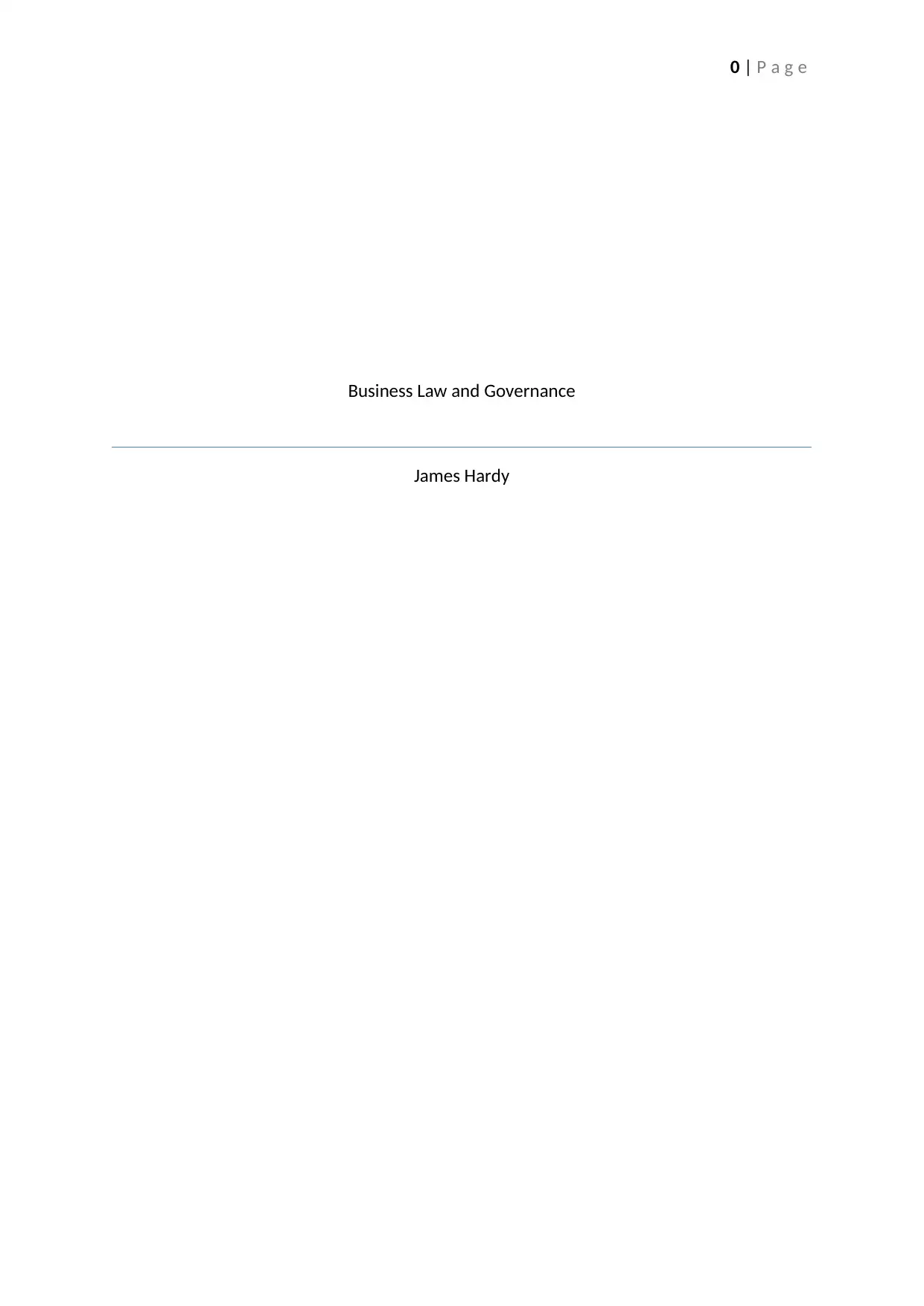
0 | P a g e
Business Law and Governance
James Hardy
Business Law and Governance
James Hardy
Paraphrase This Document
Need a fresh take? Get an instant paraphrase of this document with our AI Paraphraser
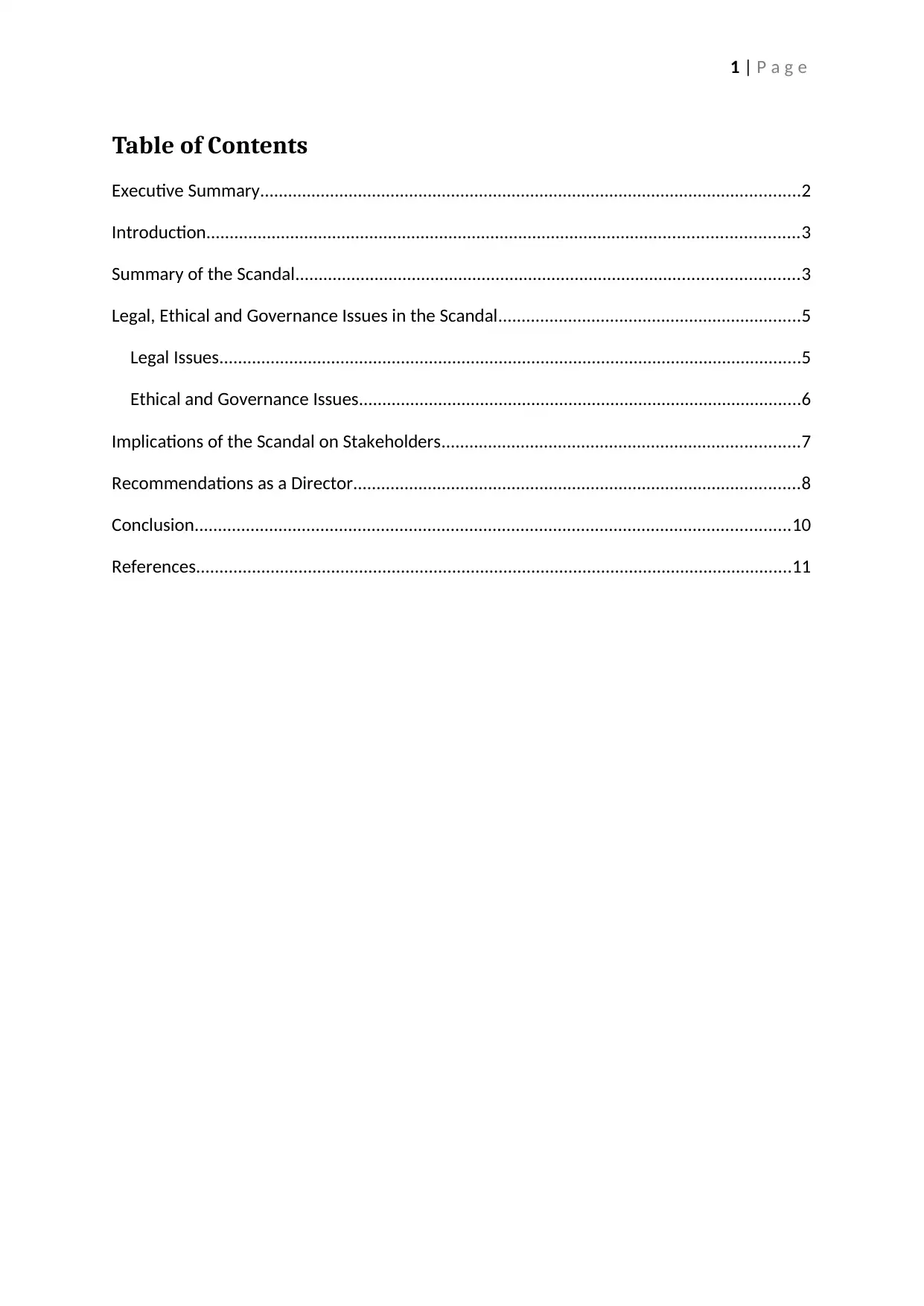
1 | P a g e
Table of Contents
Executive Summary....................................................................................................................2
Introduction...............................................................................................................................3
Summary of the Scandal............................................................................................................3
Legal, Ethical and Governance Issues in the Scandal.................................................................5
Legal Issues.............................................................................................................................5
Ethical and Governance Issues...............................................................................................6
Implications of the Scandal on Stakeholders.............................................................................7
Recommendations as a Director................................................................................................8
Conclusion................................................................................................................................10
References................................................................................................................................11
Table of Contents
Executive Summary....................................................................................................................2
Introduction...............................................................................................................................3
Summary of the Scandal............................................................................................................3
Legal, Ethical and Governance Issues in the Scandal.................................................................5
Legal Issues.............................................................................................................................5
Ethical and Governance Issues...............................................................................................6
Implications of the Scandal on Stakeholders.............................................................................7
Recommendations as a Director................................................................................................8
Conclusion................................................................................................................................10
References................................................................................................................................11

2 | P a g e
Executive Summary
The aim of this report is to select the example of a company that was engaged in a
scandal or collusion in order to evaluate the key legal, ethical and governance issues raised
by the company. James Hardie Industries Ltd is selected as the company in this report to
analyse the asbestos scandal of the company and its failure to pay compensation to its
employees. The Australian legal provisions violated by the company and its directors are
analysed in this report along with violation of key ethical and governance principles. This
report also analyse the key stakeholders who were affected by this scandal. Lastly, as a
director, what actions would I had taken to avoid this situation are also provided in this
report.
Executive Summary
The aim of this report is to select the example of a company that was engaged in a
scandal or collusion in order to evaluate the key legal, ethical and governance issues raised
by the company. James Hardie Industries Ltd is selected as the company in this report to
analyse the asbestos scandal of the company and its failure to pay compensation to its
employees. The Australian legal provisions violated by the company and its directors are
analysed in this report along with violation of key ethical and governance principles. This
report also analyse the key stakeholders who were affected by this scandal. Lastly, as a
director, what actions would I had taken to avoid this situation are also provided in this
report.
⊘ This is a preview!⊘
Do you want full access?
Subscribe today to unlock all pages.

Trusted by 1+ million students worldwide

3 | P a g e
Introduction
In today’s competitive business world, companies are expected to effectively comply
with business laws and ethical principles while engaging in their operations to make sure
that they maintain a balance between the interests of their stakeholders. The
responsibilities for directors has increased in companies as the impact of companies
increases on society; therefore, directors have to make sure that they comply with relevant
business laws and ethical principles while discharging their duties to make sure that they
avoid ethical or legal dilemmas (Weiss, 2014). The objective of this report is to select an
organisation that was recently engaged in a scandal or corporate collapse in Australia to
understand the key legal, ethical and governance issues raised in this scandal and their
impact on stakeholders and the role of directors to avoid these scandals. The example of
James Hardie Industries is selected in this report which was recently involved in the
Asbestos scandal. This report will include a summary of the scandal along with the
identification of parties that were responsible for this scandal. This report will also identify
the key legal, ethical and governance issue that arises in the scandal. The implication of the
scandal on organisational stakeholders and the company will also be analysed in this report.
Lastly, this report will outline how as a company director, I had taken actions to avoid this
situation.
Summary of the Scandal
Asbestos is a mineral that is mined and used for commercial purposes for centuries
by companies. In 1982, it was used to build more than 30 per cent of Australian homes, and
it was also used to construct schools and other buildings (Moerman & Van Der Laan, 2015).
However, the key issue with this mineral is that it causes significant health problems such as
mesothelioma and lung cancer. James Hardie Industries Ltd is a major Australian
corporation that also used asbestos in order to manufacture building materials, particularly
fibrocement sheeting (Moerman & Van Der Laan, 2015). During the 1960s, the company
learn about the negative health implications of asbestos on its employees; however, no
actions were taken by the company to increase their safety. In 1978, the corporation started
to put warning stickers on its products in order to inform the handles regarding the fact that
the dust from the product may cause cancer. Employees who worked for the company faced
Introduction
In today’s competitive business world, companies are expected to effectively comply
with business laws and ethical principles while engaging in their operations to make sure
that they maintain a balance between the interests of their stakeholders. The
responsibilities for directors has increased in companies as the impact of companies
increases on society; therefore, directors have to make sure that they comply with relevant
business laws and ethical principles while discharging their duties to make sure that they
avoid ethical or legal dilemmas (Weiss, 2014). The objective of this report is to select an
organisation that was recently engaged in a scandal or corporate collapse in Australia to
understand the key legal, ethical and governance issues raised in this scandal and their
impact on stakeholders and the role of directors to avoid these scandals. The example of
James Hardie Industries is selected in this report which was recently involved in the
Asbestos scandal. This report will include a summary of the scandal along with the
identification of parties that were responsible for this scandal. This report will also identify
the key legal, ethical and governance issue that arises in the scandal. The implication of the
scandal on organisational stakeholders and the company will also be analysed in this report.
Lastly, this report will outline how as a company director, I had taken actions to avoid this
situation.
Summary of the Scandal
Asbestos is a mineral that is mined and used for commercial purposes for centuries
by companies. In 1982, it was used to build more than 30 per cent of Australian homes, and
it was also used to construct schools and other buildings (Moerman & Van Der Laan, 2015).
However, the key issue with this mineral is that it causes significant health problems such as
mesothelioma and lung cancer. James Hardie Industries Ltd is a major Australian
corporation that also used asbestos in order to manufacture building materials, particularly
fibrocement sheeting (Moerman & Van Der Laan, 2015). During the 1960s, the company
learn about the negative health implications of asbestos on its employees; however, no
actions were taken by the company to increase their safety. In 1978, the corporation started
to put warning stickers on its products in order to inform the handles regarding the fact that
the dust from the product may cause cancer. Employees who worked for the company faced
Paraphrase This Document
Need a fresh take? Get an instant paraphrase of this document with our AI Paraphraser
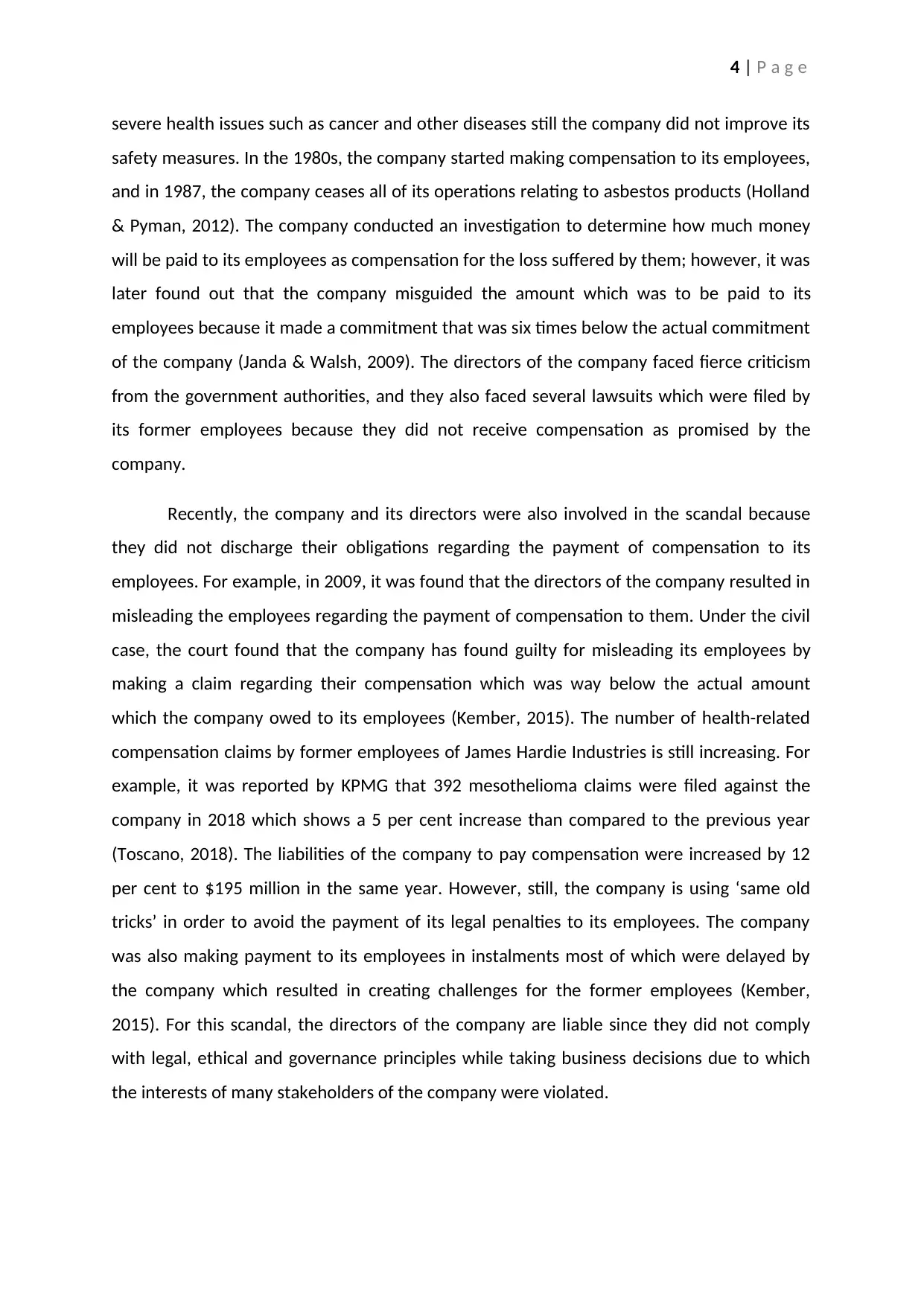
4 | P a g e
severe health issues such as cancer and other diseases still the company did not improve its
safety measures. In the 1980s, the company started making compensation to its employees,
and in 1987, the company ceases all of its operations relating to asbestos products (Holland
& Pyman, 2012). The company conducted an investigation to determine how much money
will be paid to its employees as compensation for the loss suffered by them; however, it was
later found out that the company misguided the amount which was to be paid to its
employees because it made a commitment that was six times below the actual commitment
of the company (Janda & Walsh, 2009). The directors of the company faced fierce criticism
from the government authorities, and they also faced several lawsuits which were filed by
its former employees because they did not receive compensation as promised by the
company.
Recently, the company and its directors were also involved in the scandal because
they did not discharge their obligations regarding the payment of compensation to its
employees. For example, in 2009, it was found that the directors of the company resulted in
misleading the employees regarding the payment of compensation to them. Under the civil
case, the court found that the company has found guilty for misleading its employees by
making a claim regarding their compensation which was way below the actual amount
which the company owed to its employees (Kember, 2015). The number of health-related
compensation claims by former employees of James Hardie Industries is still increasing. For
example, it was reported by KPMG that 392 mesothelioma claims were filed against the
company in 2018 which shows a 5 per cent increase than compared to the previous year
(Toscano, 2018). The liabilities of the company to pay compensation were increased by 12
per cent to $195 million in the same year. However, still, the company is using ‘same old
tricks’ in order to avoid the payment of its legal penalties to its employees. The company
was also making payment to its employees in instalments most of which were delayed by
the company which resulted in creating challenges for the former employees (Kember,
2015). For this scandal, the directors of the company are liable since they did not comply
with legal, ethical and governance principles while taking business decisions due to which
the interests of many stakeholders of the company were violated.
severe health issues such as cancer and other diseases still the company did not improve its
safety measures. In the 1980s, the company started making compensation to its employees,
and in 1987, the company ceases all of its operations relating to asbestos products (Holland
& Pyman, 2012). The company conducted an investigation to determine how much money
will be paid to its employees as compensation for the loss suffered by them; however, it was
later found out that the company misguided the amount which was to be paid to its
employees because it made a commitment that was six times below the actual commitment
of the company (Janda & Walsh, 2009). The directors of the company faced fierce criticism
from the government authorities, and they also faced several lawsuits which were filed by
its former employees because they did not receive compensation as promised by the
company.
Recently, the company and its directors were also involved in the scandal because
they did not discharge their obligations regarding the payment of compensation to its
employees. For example, in 2009, it was found that the directors of the company resulted in
misleading the employees regarding the payment of compensation to them. Under the civil
case, the court found that the company has found guilty for misleading its employees by
making a claim regarding their compensation which was way below the actual amount
which the company owed to its employees (Kember, 2015). The number of health-related
compensation claims by former employees of James Hardie Industries is still increasing. For
example, it was reported by KPMG that 392 mesothelioma claims were filed against the
company in 2018 which shows a 5 per cent increase than compared to the previous year
(Toscano, 2018). The liabilities of the company to pay compensation were increased by 12
per cent to $195 million in the same year. However, still, the company is using ‘same old
tricks’ in order to avoid the payment of its legal penalties to its employees. The company
was also making payment to its employees in instalments most of which were delayed by
the company which resulted in creating challenges for the former employees (Kember,
2015). For this scandal, the directors of the company are liable since they did not comply
with legal, ethical and governance principles while taking business decisions due to which
the interests of many stakeholders of the company were violated.
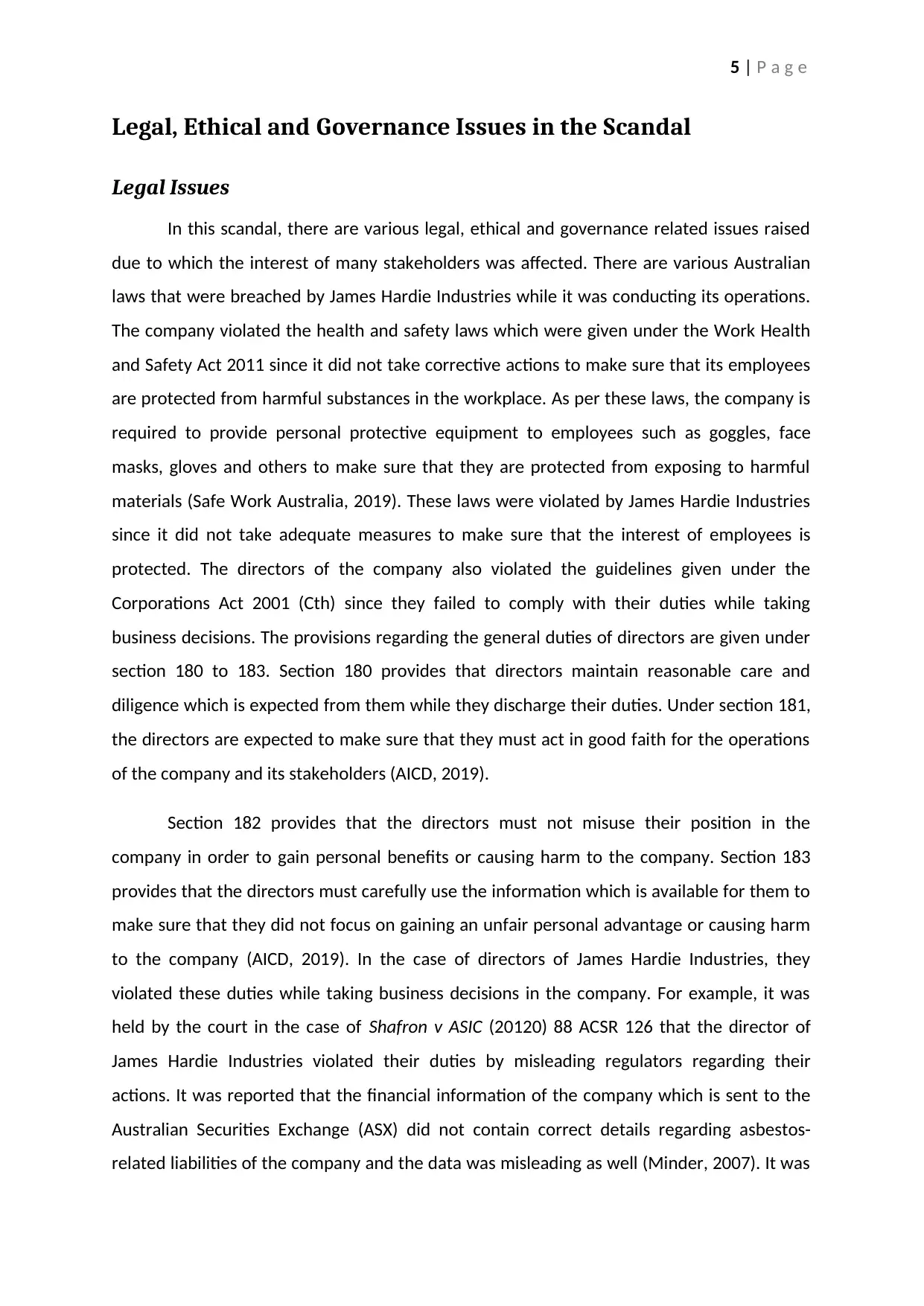
5 | P a g e
Legal, Ethical and Governance Issues in the Scandal
Legal Issues
In this scandal, there are various legal, ethical and governance related issues raised
due to which the interest of many stakeholders was affected. There are various Australian
laws that were breached by James Hardie Industries while it was conducting its operations.
The company violated the health and safety laws which were given under the Work Health
and Safety Act 2011 since it did not take corrective actions to make sure that its employees
are protected from harmful substances in the workplace. As per these laws, the company is
required to provide personal protective equipment to employees such as goggles, face
masks, gloves and others to make sure that they are protected from exposing to harmful
materials (Safe Work Australia, 2019). These laws were violated by James Hardie Industries
since it did not take adequate measures to make sure that the interest of employees is
protected. The directors of the company also violated the guidelines given under the
Corporations Act 2001 (Cth) since they failed to comply with their duties while taking
business decisions. The provisions regarding the general duties of directors are given under
section 180 to 183. Section 180 provides that directors maintain reasonable care and
diligence which is expected from them while they discharge their duties. Under section 181,
the directors are expected to make sure that they must act in good faith for the operations
of the company and its stakeholders (AICD, 2019).
Section 182 provides that the directors must not misuse their position in the
company in order to gain personal benefits or causing harm to the company. Section 183
provides that the directors must carefully use the information which is available for them to
make sure that they did not focus on gaining an unfair personal advantage or causing harm
to the company (AICD, 2019). In the case of directors of James Hardie Industries, they
violated these duties while taking business decisions in the company. For example, it was
held by the court in the case of Shafron v ASIC (20120) 88 ACSR 126 that the director of
James Hardie Industries violated their duties by misleading regulators regarding their
actions. It was reported that the financial information of the company which is sent to the
Australian Securities Exchange (ASX) did not contain correct details regarding asbestos-
related liabilities of the company and the data was misleading as well (Minder, 2007). It was
Legal, Ethical and Governance Issues in the Scandal
Legal Issues
In this scandal, there are various legal, ethical and governance related issues raised
due to which the interest of many stakeholders was affected. There are various Australian
laws that were breached by James Hardie Industries while it was conducting its operations.
The company violated the health and safety laws which were given under the Work Health
and Safety Act 2011 since it did not take corrective actions to make sure that its employees
are protected from harmful substances in the workplace. As per these laws, the company is
required to provide personal protective equipment to employees such as goggles, face
masks, gloves and others to make sure that they are protected from exposing to harmful
materials (Safe Work Australia, 2019). These laws were violated by James Hardie Industries
since it did not take adequate measures to make sure that the interest of employees is
protected. The directors of the company also violated the guidelines given under the
Corporations Act 2001 (Cth) since they failed to comply with their duties while taking
business decisions. The provisions regarding the general duties of directors are given under
section 180 to 183. Section 180 provides that directors maintain reasonable care and
diligence which is expected from them while they discharge their duties. Under section 181,
the directors are expected to make sure that they must act in good faith for the operations
of the company and its stakeholders (AICD, 2019).
Section 182 provides that the directors must not misuse their position in the
company in order to gain personal benefits or causing harm to the company. Section 183
provides that the directors must carefully use the information which is available for them to
make sure that they did not focus on gaining an unfair personal advantage or causing harm
to the company (AICD, 2019). In the case of directors of James Hardie Industries, they
violated these duties while taking business decisions in the company. For example, it was
held by the court in the case of Shafron v ASIC (20120) 88 ACSR 126 that the director of
James Hardie Industries violated their duties by misleading regulators regarding their
actions. It was reported that the financial information of the company which is sent to the
Australian Securities Exchange (ASX) did not contain correct details regarding asbestos-
related liabilities of the company and the data was misleading as well (Minder, 2007). It was
⊘ This is a preview!⊘
Do you want full access?
Subscribe today to unlock all pages.

Trusted by 1+ million students worldwide
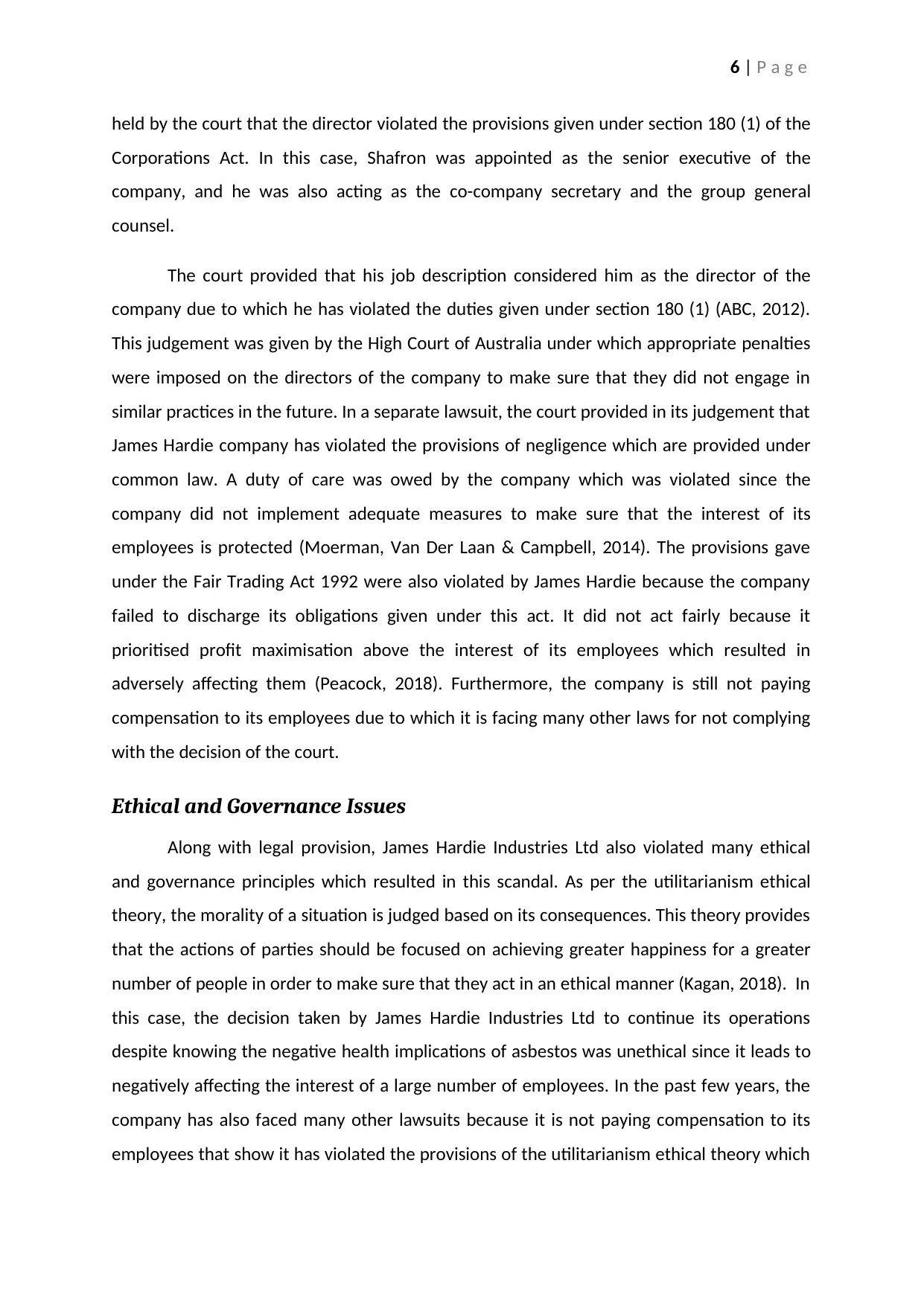
6 | P a g e
held by the court that the director violated the provisions given under section 180 (1) of the
Corporations Act. In this case, Shafron was appointed as the senior executive of the
company, and he was also acting as the co-company secretary and the group general
counsel.
The court provided that his job description considered him as the director of the
company due to which he has violated the duties given under section 180 (1) (ABC, 2012).
This judgement was given by the High Court of Australia under which appropriate penalties
were imposed on the directors of the company to make sure that they did not engage in
similar practices in the future. In a separate lawsuit, the court provided in its judgement that
James Hardie company has violated the provisions of negligence which are provided under
common law. A duty of care was owed by the company which was violated since the
company did not implement adequate measures to make sure that the interest of its
employees is protected (Moerman, Van Der Laan & Campbell, 2014). The provisions gave
under the Fair Trading Act 1992 were also violated by James Hardie because the company
failed to discharge its obligations given under this act. It did not act fairly because it
prioritised profit maximisation above the interest of its employees which resulted in
adversely affecting them (Peacock, 2018). Furthermore, the company is still not paying
compensation to its employees due to which it is facing many other laws for not complying
with the decision of the court.
Ethical and Governance Issues
Along with legal provision, James Hardie Industries Ltd also violated many ethical
and governance principles which resulted in this scandal. As per the utilitarianism ethical
theory, the morality of a situation is judged based on its consequences. This theory provides
that the actions of parties should be focused on achieving greater happiness for a greater
number of people in order to make sure that they act in an ethical manner (Kagan, 2018). In
this case, the decision taken by James Hardie Industries Ltd to continue its operations
despite knowing the negative health implications of asbestos was unethical since it leads to
negatively affecting the interest of a large number of employees. In the past few years, the
company has also faced many other lawsuits because it is not paying compensation to its
employees that show it has violated the provisions of the utilitarianism ethical theory which
held by the court that the director violated the provisions given under section 180 (1) of the
Corporations Act. In this case, Shafron was appointed as the senior executive of the
company, and he was also acting as the co-company secretary and the group general
counsel.
The court provided that his job description considered him as the director of the
company due to which he has violated the duties given under section 180 (1) (ABC, 2012).
This judgement was given by the High Court of Australia under which appropriate penalties
were imposed on the directors of the company to make sure that they did not engage in
similar practices in the future. In a separate lawsuit, the court provided in its judgement that
James Hardie company has violated the provisions of negligence which are provided under
common law. A duty of care was owed by the company which was violated since the
company did not implement adequate measures to make sure that the interest of its
employees is protected (Moerman, Van Der Laan & Campbell, 2014). The provisions gave
under the Fair Trading Act 1992 were also violated by James Hardie because the company
failed to discharge its obligations given under this act. It did not act fairly because it
prioritised profit maximisation above the interest of its employees which resulted in
adversely affecting them (Peacock, 2018). Furthermore, the company is still not paying
compensation to its employees due to which it is facing many other laws for not complying
with the decision of the court.
Ethical and Governance Issues
Along with legal provision, James Hardie Industries Ltd also violated many ethical
and governance principles which resulted in this scandal. As per the utilitarianism ethical
theory, the morality of a situation is judged based on its consequences. This theory provides
that the actions of parties should be focused on achieving greater happiness for a greater
number of people in order to make sure that they act in an ethical manner (Kagan, 2018). In
this case, the decision taken by James Hardie Industries Ltd to continue its operations
despite knowing the negative health implications of asbestos was unethical since it leads to
negatively affecting the interest of a large number of employees. In the past few years, the
company has also faced many other lawsuits because it is not paying compensation to its
employees that show it has violated the provisions of the utilitarianism ethical theory which
Paraphrase This Document
Need a fresh take? Get an instant paraphrase of this document with our AI Paraphraser
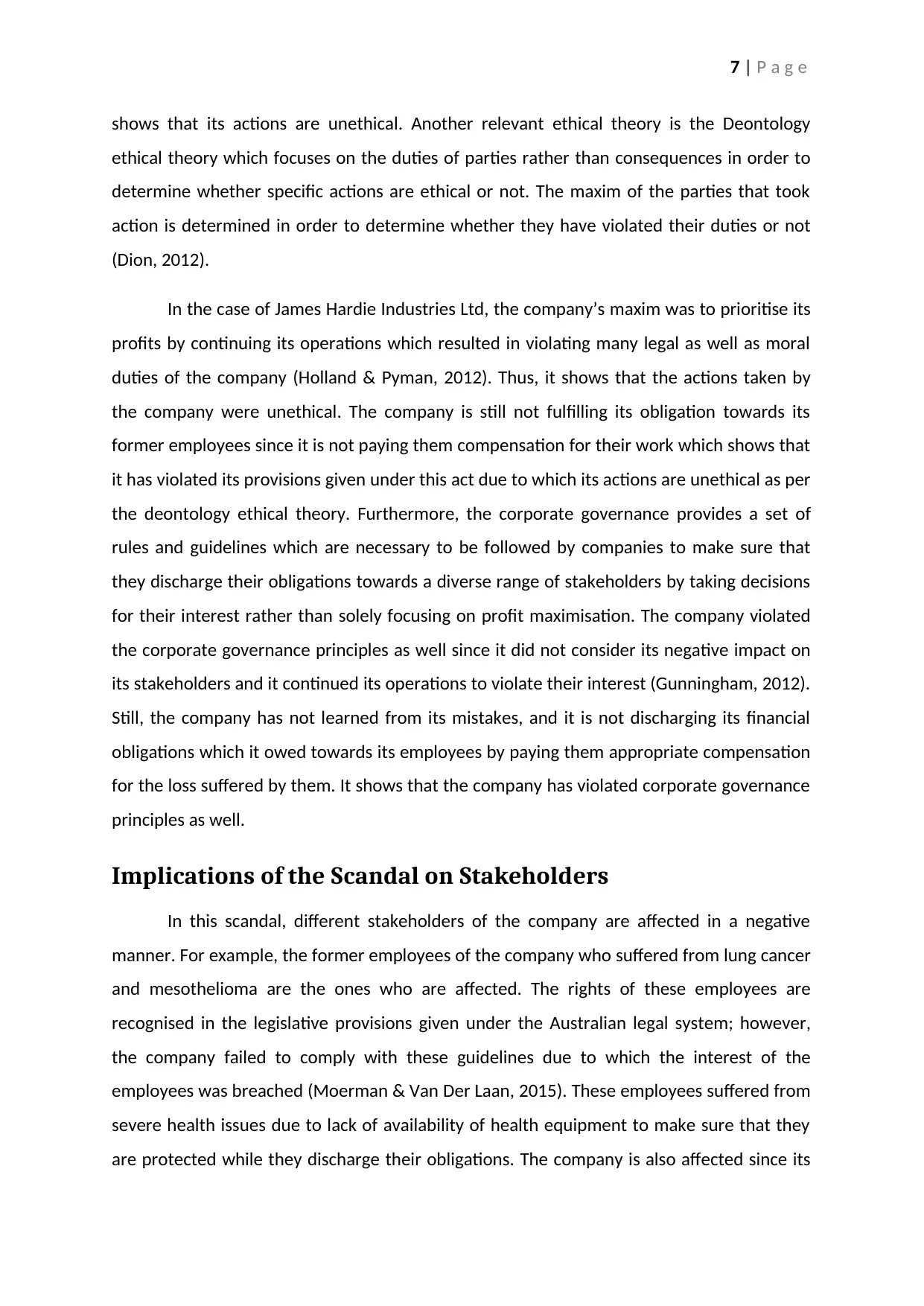
7 | P a g e
shows that its actions are unethical. Another relevant ethical theory is the Deontology
ethical theory which focuses on the duties of parties rather than consequences in order to
determine whether specific actions are ethical or not. The maxim of the parties that took
action is determined in order to determine whether they have violated their duties or not
(Dion, 2012).
In the case of James Hardie Industries Ltd, the company’s maxim was to prioritise its
profits by continuing its operations which resulted in violating many legal as well as moral
duties of the company (Holland & Pyman, 2012). Thus, it shows that the actions taken by
the company were unethical. The company is still not fulfilling its obligation towards its
former employees since it is not paying them compensation for their work which shows that
it has violated its provisions given under this act due to which its actions are unethical as per
the deontology ethical theory. Furthermore, the corporate governance provides a set of
rules and guidelines which are necessary to be followed by companies to make sure that
they discharge their obligations towards a diverse range of stakeholders by taking decisions
for their interest rather than solely focusing on profit maximisation. The company violated
the corporate governance principles as well since it did not consider its negative impact on
its stakeholders and it continued its operations to violate their interest (Gunningham, 2012).
Still, the company has not learned from its mistakes, and it is not discharging its financial
obligations which it owed towards its employees by paying them appropriate compensation
for the loss suffered by them. It shows that the company has violated corporate governance
principles as well.
Implications of the Scandal on Stakeholders
In this scandal, different stakeholders of the company are affected in a negative
manner. For example, the former employees of the company who suffered from lung cancer
and mesothelioma are the ones who are affected. The rights of these employees are
recognised in the legislative provisions given under the Australian legal system; however,
the company failed to comply with these guidelines due to which the interest of the
employees was breached (Moerman & Van Der Laan, 2015). These employees suffered from
severe health issues due to lack of availability of health equipment to make sure that they
are protected while they discharge their obligations. The company is also affected since its
shows that its actions are unethical. Another relevant ethical theory is the Deontology
ethical theory which focuses on the duties of parties rather than consequences in order to
determine whether specific actions are ethical or not. The maxim of the parties that took
action is determined in order to determine whether they have violated their duties or not
(Dion, 2012).
In the case of James Hardie Industries Ltd, the company’s maxim was to prioritise its
profits by continuing its operations which resulted in violating many legal as well as moral
duties of the company (Holland & Pyman, 2012). Thus, it shows that the actions taken by
the company were unethical. The company is still not fulfilling its obligation towards its
former employees since it is not paying them compensation for their work which shows that
it has violated its provisions given under this act due to which its actions are unethical as per
the deontology ethical theory. Furthermore, the corporate governance provides a set of
rules and guidelines which are necessary to be followed by companies to make sure that
they discharge their obligations towards a diverse range of stakeholders by taking decisions
for their interest rather than solely focusing on profit maximisation. The company violated
the corporate governance principles as well since it did not consider its negative impact on
its stakeholders and it continued its operations to violate their interest (Gunningham, 2012).
Still, the company has not learned from its mistakes, and it is not discharging its financial
obligations which it owed towards its employees by paying them appropriate compensation
for the loss suffered by them. It shows that the company has violated corporate governance
principles as well.
Implications of the Scandal on Stakeholders
In this scandal, different stakeholders of the company are affected in a negative
manner. For example, the former employees of the company who suffered from lung cancer
and mesothelioma are the ones who are affected. The rights of these employees are
recognised in the legislative provisions given under the Australian legal system; however,
the company failed to comply with these guidelines due to which the interest of the
employees was breached (Moerman & Van Der Laan, 2015). These employees suffered from
severe health issues due to lack of availability of health equipment to make sure that they
are protected while they discharge their obligations. The company is also affected since its
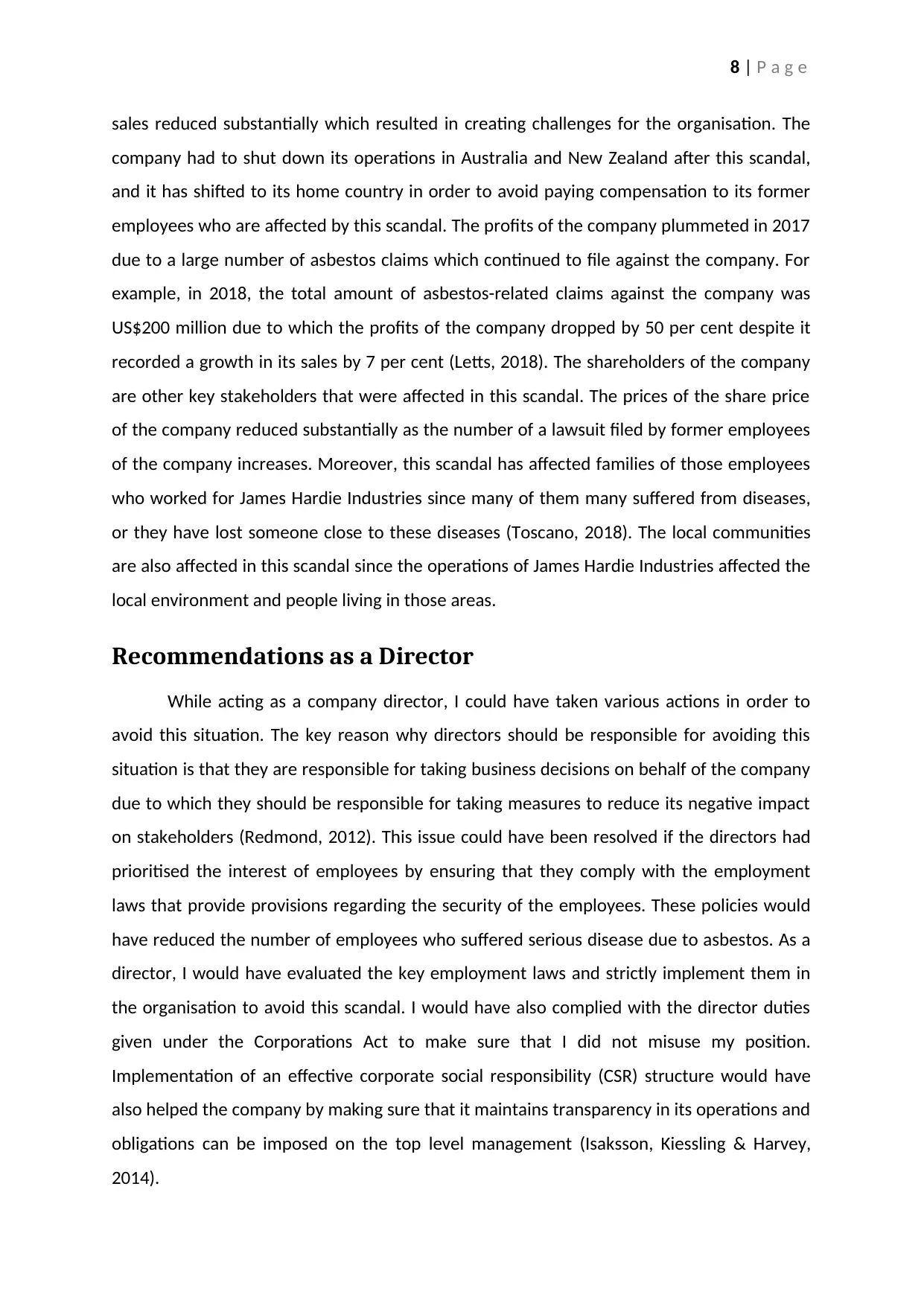
8 | P a g e
sales reduced substantially which resulted in creating challenges for the organisation. The
company had to shut down its operations in Australia and New Zealand after this scandal,
and it has shifted to its home country in order to avoid paying compensation to its former
employees who are affected by this scandal. The profits of the company plummeted in 2017
due to a large number of asbestos claims which continued to file against the company. For
example, in 2018, the total amount of asbestos-related claims against the company was
US$200 million due to which the profits of the company dropped by 50 per cent despite it
recorded a growth in its sales by 7 per cent (Letts, 2018). The shareholders of the company
are other key stakeholders that were affected in this scandal. The prices of the share price
of the company reduced substantially as the number of a lawsuit filed by former employees
of the company increases. Moreover, this scandal has affected families of those employees
who worked for James Hardie Industries since many of them many suffered from diseases,
or they have lost someone close to these diseases (Toscano, 2018). The local communities
are also affected in this scandal since the operations of James Hardie Industries affected the
local environment and people living in those areas.
Recommendations as a Director
While acting as a company director, I could have taken various actions in order to
avoid this situation. The key reason why directors should be responsible for avoiding this
situation is that they are responsible for taking business decisions on behalf of the company
due to which they should be responsible for taking measures to reduce its negative impact
on stakeholders (Redmond, 2012). This issue could have been resolved if the directors had
prioritised the interest of employees by ensuring that they comply with the employment
laws that provide provisions regarding the security of the employees. These policies would
have reduced the number of employees who suffered serious disease due to asbestos. As a
director, I would have evaluated the key employment laws and strictly implement them in
the organisation to avoid this scandal. I would have also complied with the director duties
given under the Corporations Act to make sure that I did not misuse my position.
Implementation of an effective corporate social responsibility (CSR) structure would have
also helped the company by making sure that it maintains transparency in its operations and
obligations can be imposed on the top level management (Isaksson, Kiessling & Harvey,
2014).
sales reduced substantially which resulted in creating challenges for the organisation. The
company had to shut down its operations in Australia and New Zealand after this scandal,
and it has shifted to its home country in order to avoid paying compensation to its former
employees who are affected by this scandal. The profits of the company plummeted in 2017
due to a large number of asbestos claims which continued to file against the company. For
example, in 2018, the total amount of asbestos-related claims against the company was
US$200 million due to which the profits of the company dropped by 50 per cent despite it
recorded a growth in its sales by 7 per cent (Letts, 2018). The shareholders of the company
are other key stakeholders that were affected in this scandal. The prices of the share price
of the company reduced substantially as the number of a lawsuit filed by former employees
of the company increases. Moreover, this scandal has affected families of those employees
who worked for James Hardie Industries since many of them many suffered from diseases,
or they have lost someone close to these diseases (Toscano, 2018). The local communities
are also affected in this scandal since the operations of James Hardie Industries affected the
local environment and people living in those areas.
Recommendations as a Director
While acting as a company director, I could have taken various actions in order to
avoid this situation. The key reason why directors should be responsible for avoiding this
situation is that they are responsible for taking business decisions on behalf of the company
due to which they should be responsible for taking measures to reduce its negative impact
on stakeholders (Redmond, 2012). This issue could have been resolved if the directors had
prioritised the interest of employees by ensuring that they comply with the employment
laws that provide provisions regarding the security of the employees. These policies would
have reduced the number of employees who suffered serious disease due to asbestos. As a
director, I would have evaluated the key employment laws and strictly implement them in
the organisation to avoid this scandal. I would have also complied with the director duties
given under the Corporations Act to make sure that I did not misuse my position.
Implementation of an effective corporate social responsibility (CSR) structure would have
also helped the company by making sure that it maintains transparency in its operations and
obligations can be imposed on the top level management (Isaksson, Kiessling & Harvey,
2014).
⊘ This is a preview!⊘
Do you want full access?
Subscribe today to unlock all pages.

Trusted by 1+ million students worldwide
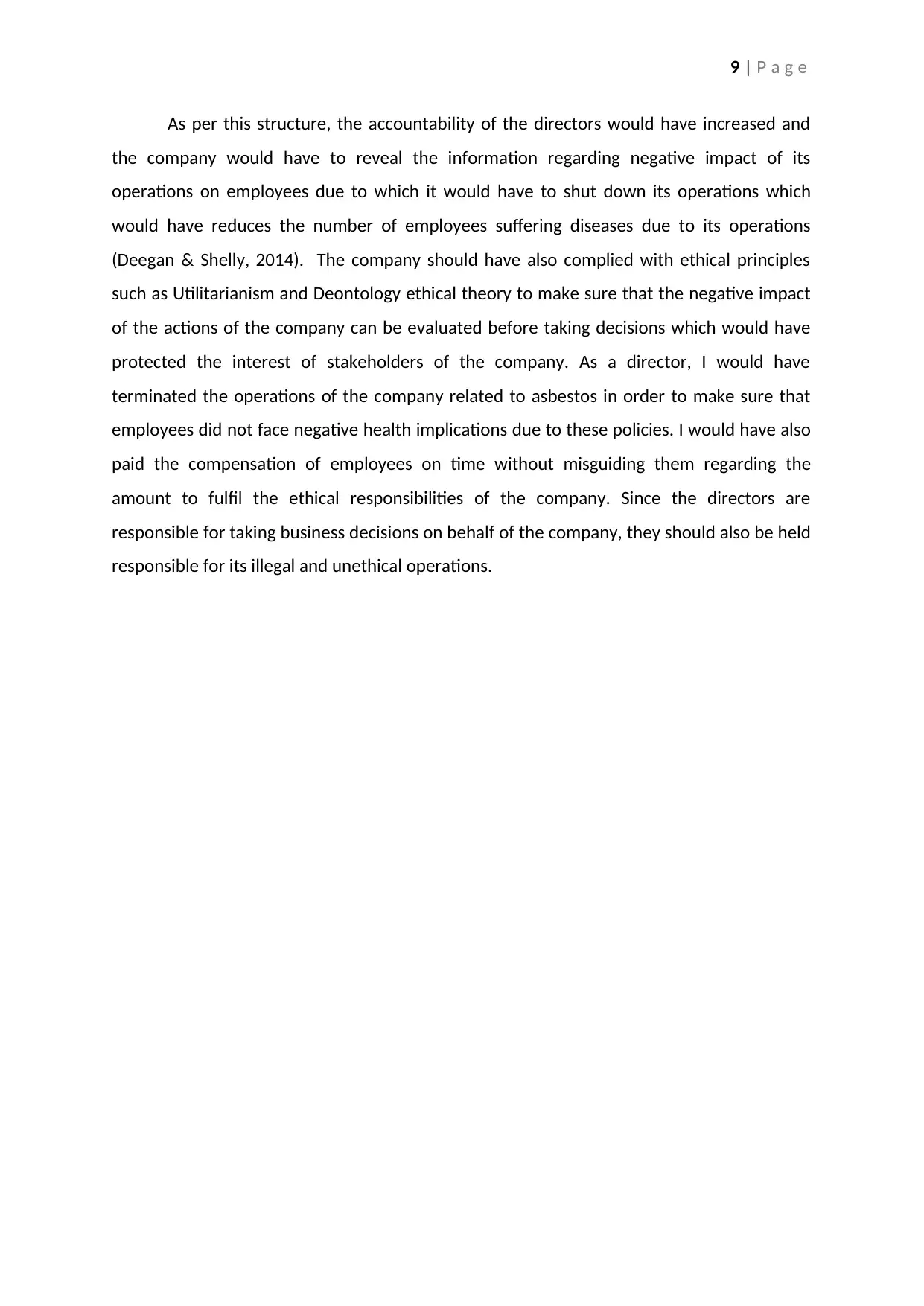
9 | P a g e
As per this structure, the accountability of the directors would have increased and
the company would have to reveal the information regarding negative impact of its
operations on employees due to which it would have to shut down its operations which
would have reduces the number of employees suffering diseases due to its operations
(Deegan & Shelly, 2014). The company should have also complied with ethical principles
such as Utilitarianism and Deontology ethical theory to make sure that the negative impact
of the actions of the company can be evaluated before taking decisions which would have
protected the interest of stakeholders of the company. As a director, I would have
terminated the operations of the company related to asbestos in order to make sure that
employees did not face negative health implications due to these policies. I would have also
paid the compensation of employees on time without misguiding them regarding the
amount to fulfil the ethical responsibilities of the company. Since the directors are
responsible for taking business decisions on behalf of the company, they should also be held
responsible for its illegal and unethical operations.
As per this structure, the accountability of the directors would have increased and
the company would have to reveal the information regarding negative impact of its
operations on employees due to which it would have to shut down its operations which
would have reduces the number of employees suffering diseases due to its operations
(Deegan & Shelly, 2014). The company should have also complied with ethical principles
such as Utilitarianism and Deontology ethical theory to make sure that the negative impact
of the actions of the company can be evaluated before taking decisions which would have
protected the interest of stakeholders of the company. As a director, I would have
terminated the operations of the company related to asbestos in order to make sure that
employees did not face negative health implications due to these policies. I would have also
paid the compensation of employees on time without misguiding them regarding the
amount to fulfil the ethical responsibilities of the company. Since the directors are
responsible for taking business decisions on behalf of the company, they should also be held
responsible for its illegal and unethical operations.
Paraphrase This Document
Need a fresh take? Get an instant paraphrase of this document with our AI Paraphraser

10 | P a g e
Conclusion
Based on the above observations, it can be concluded that the significance of
business law, ethics and governance can be highlighted by the case of James Hardie
Industries Ltd which was involved in the asbestos scandal. Despite knowing that asbestos
causes many severe health issues, the company continued its operations due to which many
of the employees of the company suffered serious health issues. The company and its
director misguided the Australian regulators by making a false representation of the
compensation which it owed to its employees. The company is still avoiding paying the
compensation to its employees that has raises many legal, ethics and governance issues.
The company has violated provisions given under the Fair Trading Act, Corporations Act and
Work Health and Safety Act. Moreover, the actions of the company are unethical, and they
did not comply with corporate governance guidelines. The directors of the company are
responsible for this scandal in which different stakeholders were affected such as former
employees, shareholders, local communities and the company itself. The role of a director in
addressing this issue is also highlighted in this report to avoid the situation such as
compliance with legal provisions, termination of operations, the establishment of an
effective CSR structure and compliance with ethical guidelines.
Conclusion
Based on the above observations, it can be concluded that the significance of
business law, ethics and governance can be highlighted by the case of James Hardie
Industries Ltd which was involved in the asbestos scandal. Despite knowing that asbestos
causes many severe health issues, the company continued its operations due to which many
of the employees of the company suffered serious health issues. The company and its
director misguided the Australian regulators by making a false representation of the
compensation which it owed to its employees. The company is still avoiding paying the
compensation to its employees that has raises many legal, ethics and governance issues.
The company has violated provisions given under the Fair Trading Act, Corporations Act and
Work Health and Safety Act. Moreover, the actions of the company are unethical, and they
did not comply with corporate governance guidelines. The directors of the company are
responsible for this scandal in which different stakeholders were affected such as former
employees, shareholders, local communities and the company itself. The role of a director in
addressing this issue is also highlighted in this report to avoid the situation such as
compliance with legal provisions, termination of operations, the establishment of an
effective CSR structure and compliance with ethical guidelines.
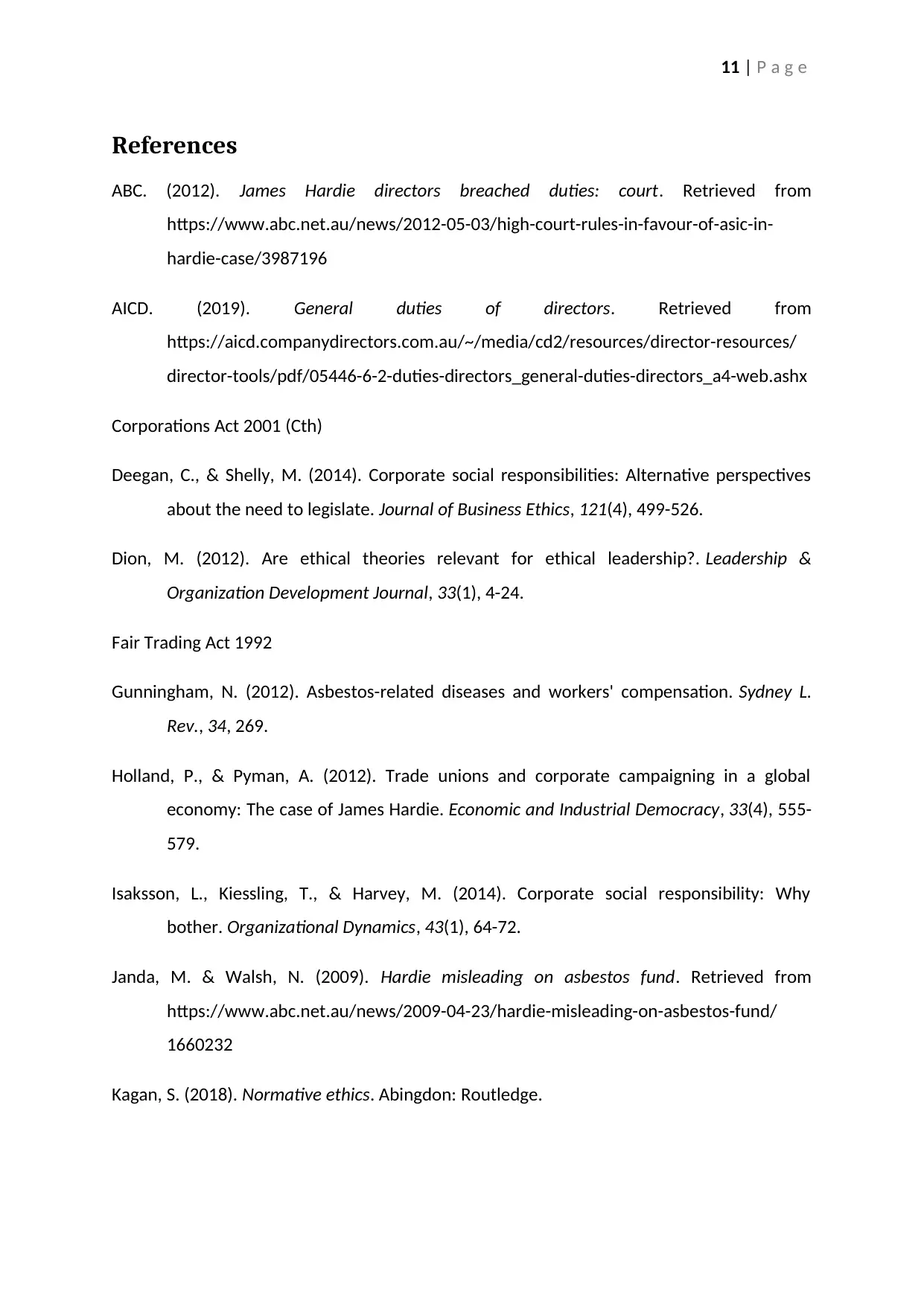
11 | P a g e
References
ABC. (2012). James Hardie directors breached duties: court. Retrieved from
https://www.abc.net.au/news/2012-05-03/high-court-rules-in-favour-of-asic-in-
hardie-case/3987196
AICD. (2019). General duties of directors. Retrieved from
https://aicd.companydirectors.com.au/~/media/cd2/resources/director-resources/
director-tools/pdf/05446-6-2-duties-directors_general-duties-directors_a4-web.ashx
Corporations Act 2001 (Cth)
Deegan, C., & Shelly, M. (2014). Corporate social responsibilities: Alternative perspectives
about the need to legislate. Journal of Business Ethics, 121(4), 499-526.
Dion, M. (2012). Are ethical theories relevant for ethical leadership?. Leadership &
Organization Development Journal, 33(1), 4-24.
Fair Trading Act 1992
Gunningham, N. (2012). Asbestos-related diseases and workers' compensation. Sydney L.
Rev., 34, 269.
Holland, P., & Pyman, A. (2012). Trade unions and corporate campaigning in a global
economy: The case of James Hardie. Economic and Industrial Democracy, 33(4), 555-
579.
Isaksson, L., Kiessling, T., & Harvey, M. (2014). Corporate social responsibility: Why
bother. Organizational Dynamics, 43(1), 64-72.
Janda, M. & Walsh, N. (2009). Hardie misleading on asbestos fund. Retrieved from
https://www.abc.net.au/news/2009-04-23/hardie-misleading-on-asbestos-fund/
1660232
Kagan, S. (2018). Normative ethics. Abingdon: Routledge.
References
ABC. (2012). James Hardie directors breached duties: court. Retrieved from
https://www.abc.net.au/news/2012-05-03/high-court-rules-in-favour-of-asic-in-
hardie-case/3987196
AICD. (2019). General duties of directors. Retrieved from
https://aicd.companydirectors.com.au/~/media/cd2/resources/director-resources/
director-tools/pdf/05446-6-2-duties-directors_general-duties-directors_a4-web.ashx
Corporations Act 2001 (Cth)
Deegan, C., & Shelly, M. (2014). Corporate social responsibilities: Alternative perspectives
about the need to legislate. Journal of Business Ethics, 121(4), 499-526.
Dion, M. (2012). Are ethical theories relevant for ethical leadership?. Leadership &
Organization Development Journal, 33(1), 4-24.
Fair Trading Act 1992
Gunningham, N. (2012). Asbestos-related diseases and workers' compensation. Sydney L.
Rev., 34, 269.
Holland, P., & Pyman, A. (2012). Trade unions and corporate campaigning in a global
economy: The case of James Hardie. Economic and Industrial Democracy, 33(4), 555-
579.
Isaksson, L., Kiessling, T., & Harvey, M. (2014). Corporate social responsibility: Why
bother. Organizational Dynamics, 43(1), 64-72.
Janda, M. & Walsh, N. (2009). Hardie misleading on asbestos fund. Retrieved from
https://www.abc.net.au/news/2009-04-23/hardie-misleading-on-asbestos-fund/
1660232
Kagan, S. (2018). Normative ethics. Abingdon: Routledge.
⊘ This is a preview!⊘
Do you want full access?
Subscribe today to unlock all pages.

Trusted by 1+ million students worldwide
1 out of 13
Related Documents
Your All-in-One AI-Powered Toolkit for Academic Success.
+13062052269
info@desklib.com
Available 24*7 on WhatsApp / Email
![[object Object]](/_next/static/media/star-bottom.7253800d.svg)
Unlock your academic potential
Copyright © 2020–2025 A2Z Services. All Rights Reserved. Developed and managed by ZUCOL.




